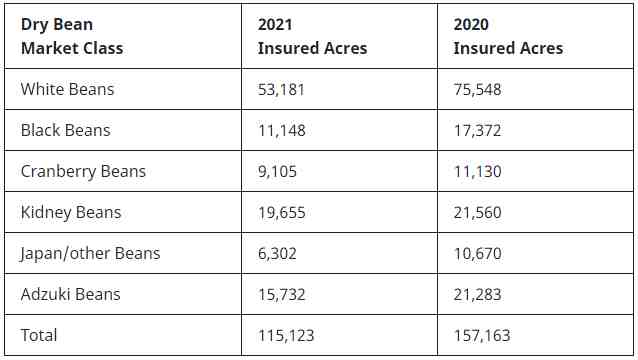Acreage, Planting and Harvest
In 2020, Ontario dry bean acres were at their highest since 2007. This year, insured acres of dry beans totalled around 115,000 which is comparable to the 10-year average. Acreage of each market class declined in 2021, although the decrease in kidney bean acres was relatively small.

Table 1. Dry bean acreage by market class in 2020 and 2021 in Ontario
Dry beans were planted in good conditions, and many were planted on the early side, in late May or early June. Although there was a light frost after seeding, there were few reports of damaged dry beans needing to be replanted. After a dry start, rains were welcomed in mid- to late-June but in some areas heavy rains contributed to significant injury from root rot complex. Fields along Lake Huron were extremely yellow and slow growing due to root rot injury, resulting in below average yields.
Group 27 “bleaching” herbicide injury was observed in dry bean fields again this year. Dry beans frequently follow corn in rotation, and Group 27 products are commonly used in corn. See Table 2 for the interval required after application of these herbicides before seeding dry beans. If conditions are cool and dry for the month following application of a Group 27 herbicide, breakdown in the soil may be slower. Herbicide breakdown may also be slower where soil pH is <6.8 or >7.3. Additional stresses on the dry beans, including compaction, adverse weather conditions or injury from in-crop herbicides, can exacerbate Group 27 injury. Different market classes may respond differently to Group 27 herbicide carryover.

Table 2. Intervals for planting dry beans after application of Group 27 herbicides.
Much of the dry bean crop was harvested before the prolonged wet period in September and October. Bean dealers reported that most of the crop was of high quality. Large-seeded beans reportedly had a higher amount of cracked seed coats. Towards the end of harvest, beans were delivered at high moisture content and had high percent pick. For the dry beans remaining in the field at the end of October, there were significant yield and quality losses and it is estimated that about 3% of dry bean acres may be left unharvested. Agricorp yield data is not available at the time this summary report was written, but yields are estimated to be average overall.
Insects and Diseases
Western Bean Cutworm (WBC) were abundant again this year, and on average were caught in higher numbers on dry bean fields than on corn fields. Trap captures for the province peaked at the end of July, a week earlier than in 2020. Captures may peak at different times in individual regions, so it continues to be important to monitor traps on your own fields. Insecticides should be applied when bean plants have pods and after many of the eggs have hatched, which is 10 to 21 days after traps counts have peaked. This usually means insecticides should be applied between Aug 10 and 21st.
Some stink bug activity was reported in dry beans, but insects were not a major concern in dry beans this year. Producers are asked to report infestations of twospotted spider mites to OMAFRA in 2022 so that samples can be collected. Some spider mite populations in Ontario have been found to be resistant to dimethoate (Cygon, Lagon) which is the only active ingredient registered in Ontario for their control.
In a survey of 37 dry bean fields in Middlesex and Huron counties, SCN (soybean cyst nematode) was found on 4 fields. It is already known to be present on soybean fields in these counties. Growers are reminded that dry beans are susceptible to SCN and varieties with resistant traits are not available. Adzuki beans are more susceptible to SCN than soybeans and should not be grown on SCN-positive fields.
Persistent wet conditions led to concerns there would be a high incidence of white mould this season, but white mould levels were average. Most dry bean acres in Ontario are likely to have white mould inoculum but wet, humid conditions and temperatures below 28°C during flowering are also required for infection.
So-called “green patch syndrome”, where plants produce only deformed beans and then remain green after pre-harvest herbicide application, was much less of an issue this year compared to recent years. A few symptomatic plants are often seen in fields, and are most common in cranberry beans, but this year green patch damage to large areas of fields or whole fields was not reported to OMAFRA. The cause of green patch is undetermined.
Source : fieldcropnews